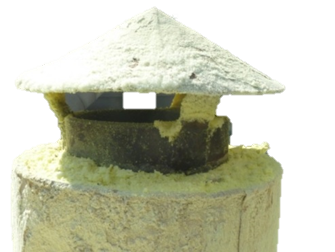How Sulphur Flour slowly destroys your sulphur plant
Sublimed sulphur is invisible for the eye and causes serious corrosion.
Sulphur is a pH neutral product, but under the right conditions and when the sulphur is in contact with air and water, bacterias can cause the formation of sulphuric acid: The pH can decrease drastically. During melting the acidity can be reduced by the addition of lime.

However, the sulphur is also present in the form of SULPHUR FLOUR. These are very fine invisible particles of sulphur in the air. The amount of sulphur flour present in the air is influenced by the vapour pressure of sulphur. This means that when the temperature is higher the sulphur flour concentration will also be higher. If we cool the air, the vapour pressure of sulphur will go down and part of the sulphur will thus sublime and form sulphur particles. Chemically, the sublimised sulphur flour is very reactive and can cause severe corrosion.
The major source for the formation of sulphur flour is the sulphur melter. The temperature is high, and the sulphur flour is dragged with the water vapour in the air, gas-phase. This is visible at the stacks of melter where sublimation is observed. When such vent is connected to a scrubber, the sulphur flour is present in the liquid phase of the scrubber. Also, the packing of scrubbers can plug by the fine sulphur flour and the systems fails to work.
The sulphur flour reacts with the carbon steel parts to form iron sulphide. For this the following chemical reactions can be expected:




Iron sulphide is visible as a dark brown or black mass with a metallic lustre, that spontaneously can ignite when exposed to oxygen in the air.
Hidden corrosion
Corrosion caused by sulphur flour very often is well hidden. The inside surfaces of the melting tank roof or other sulphur holding tanks are subject to attacks of sulphur flour.
Sulphur flour can also cause dis-functioning of measuring instruments.
If you meet troubles with sulphur flour, Sulphurnet:
- Offers more than assistance, we offer out of the box solutions to reduce corrosion problems
- Provides a complete technological proposition and a results-driven approach to help you solve corrosion issues
- Offers help to clients in the best way, we offer knowledge and expertise in sulphur processing.
Contact us for more information! We will be happy to help.
Sulphurnet Team

Your in-depth knowledge of Sulphur corrosion is very impressive. We would like to know more about it and how to prevent this corrosion.
Hello! Nice article.
Can it affect weldings on steam coils inside the suplhur melting tanks?
Regards,
Natan de Oliveira Prietto
Hi Natan,
Thank you for your question.
The heating coils are submerged, so they shouldn’t be affected. At the same time, the steam coils are on 130°C so it is not possible to have condensation of sulphur flour there.
We will give you more information by email.
Have a nice day,
Cristina
I observe the fomation of sulfur flor in the upoer part off the storage tanks.
What can be done to reduce this formation and control corrosion in these parte of the tanks?
Hi ,
We are facing these issues in severally, specially with the groundwater issue that impacts strongly each equipment such as transfer pumps , steam coils , sweep air lines , so what do you think that could solve this issue so we can avoid these kind of costly problems.
By the way our pit is for transferring the liquid sulfur up to SFU.
Thanks for sharing these great information and I’ll be glad to have your helpful solutions.
Best regards.
Thank you for your question!
We have seen this issue in the past, and have some solutions ideas we’ll share with you via email.
Where are you based?
Greetings!
Estimado, especificando hay que diferenciar si su estanque con azufre líquido es para fundir azufre los serpentines trabajarán a 168°C aproximadamente, y si su estanque es sólo para almacenar azufre líquido sus serpentines trabajaran a alrededor de 140°C, por lo que la corrosión mayor siempre es en el estanque de fusión ya que el azufre al entrar sólido al contacto con el azufre a 140°C libera vapores, que suben arrastrando polvos que se cristalizan y corroen chimeneas y toda estructura superficial, además esto tambien esta relacionado con las dimensiones del fundidor, el flujo de azufre sólido de alimentación, junto con el tamaño del estanque (tiempo de residencia), por lo que a mayor flujo de azufre sólido mayor generación de vapores, y tendrá mayor corrosión.